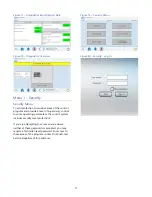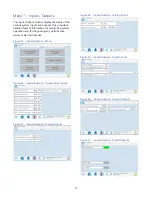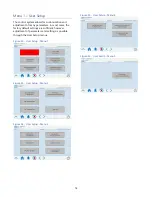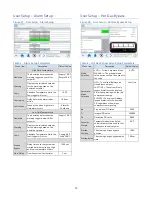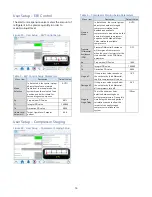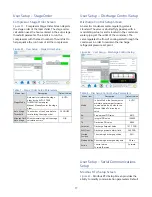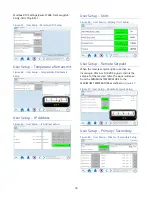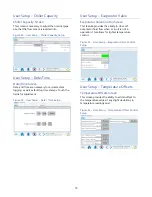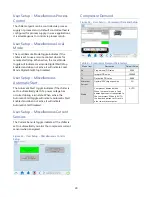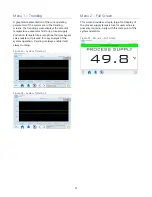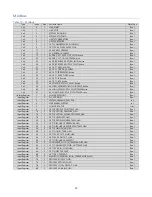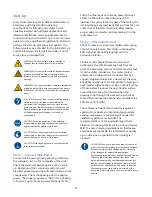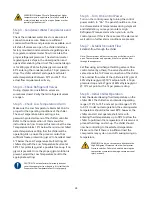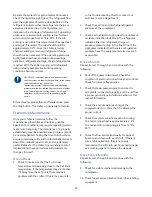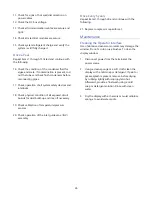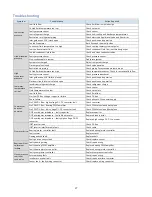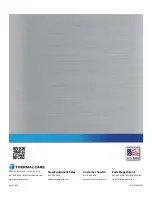
25
Operate the system for approximately 30 minutes.
Check the liquid line sight glass. The refrigerant flow
past the sight glass should be clear. Bubbles in the
refrigerant indicate either low refrigerant charge or
excessive pressure drop in the liquid line. An
indication of a shortage of refrigerant is if operating
pressures are low and sub-cooling is low. Normal
sub-cooling ranges from 15°F to 20°F. If the sub-
cooling is not within this range, check the superheat
and adjust if required. The superheat should be
approximately 2-4°F. Since the chiller is factory
charged, adding or removing refrigerant charge
should not be necessary. If the operating pressures,
sight glass, superheat, and subcooling readings
indicate a refrigerant shortage, charge refrigerant as
required. With the chiller running, add refrigerant
using industry best practices until operating
conditions become normal.
CAUTION: A clear sight glass alone does not mean
that the system is properly charged. Also, check system
superheat, subcooling, and chiller
operating pressures. If both suction and discharge
pressures are low but subcooling is normal, a problem
other than refrigerant shortage exists. Do not add
refrigerant, as this may result in overcharging the
circuit.
After achieving proper flow and temperature, press
the Stop button. The chiller is now ready for service.
Preventive Maintenance
Once your chiller is in service, follow the
maintenance procedures as closely as possible.
Specific site conditions may require repeating certain
tasks more frequently. The importance of a properly
established preventive maintenance program cannot
be overemphasized. Taking the time to follow these
simple procedures will result in substantially reduced
downtime, reduced repair costs, and an extended
useful lifetime for the chiller. Any monetary costs of
implementing these procedures will usually more
than pay for itself.
Once a Week
1.
Check to make sure that the To Process
temperature is reasonably close to the Set Point
temperature. If the temperature stays more than
5°F away from the set point, there may be a
problem with the chiller. If this is the case, refer
to the Troubleshooting Chart or contact our
Customer Service Department.
2.
Check the suction and discharge refrigerant
pressure at the compressor.
3.
Check each refrigerant sight glass for bubbles or
moisture indication. Bubbles in the refrigerant
indicate either low refrigerant charge or
excessive pressure drop in the liquid line. If the
sight glass indicates that there is a refrigeration
problem, have the equipment serviced as soon
as possible.
Once a Month
Repeat items 1 through 3 and continue with the
following.
4.
Shut off the power disconnect. Check the
condition of electrical connections at all controls.
Check for loose or frayed wires.
5.
Check the main power supply to ensure it is
acceptable, connected properly, and the unit has
a proper ground (see Installation section of this
manual for details).
6.
Check the amp draws to each leg of the
compressor(s) to confirm that it is drawing the
proper current.
7.
Check the system superheat and sub-cooling.
The normal superheat is approximately 2-4°F.
The normal sub-cooling range is from 15°F to
20°F.
8.
Check the flow sensor tip visually for signs of
build-up and clean with a soft cloth. If there is
some calcium build-up that is not easily
removed with a soft cloth use household vinegar
as a cleaning agent to remove the deposit.
Once Every 6 Months
Repeat items 1 through 8 and continue with the
following.
9.
Check for visible mechanical damage to the
compressor.
10.
Check for excessive vibration from other rotating
equipment.

